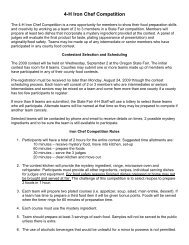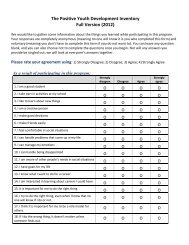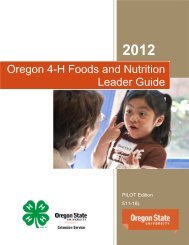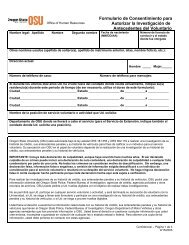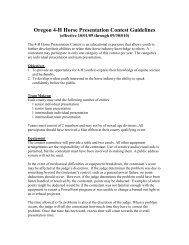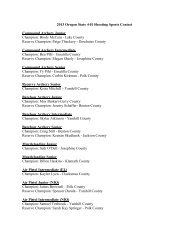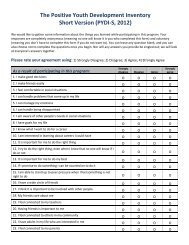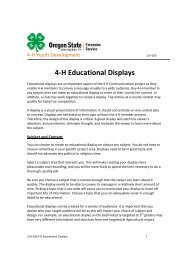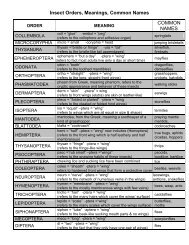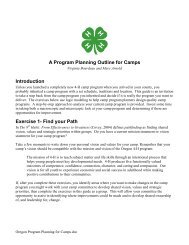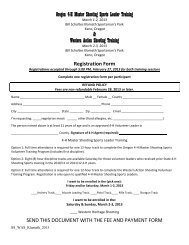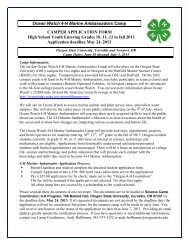Create successful ePaper yourself
Turn your PDF publications into a flip-book with our unique Google optimized e-Paper software.
Family & Consumer<br />
Science<br />
Food and Nutrition<br />
Mary Mosier, Chair<br />
Note: For information regarding Food Preparation Contest and Mini-Meal Contest, see Displays,<br />
Contest and Presentations.<br />
Each member may enter up to three classes based on the phase in which they are enrolled, one exhibit<br />
per class. All foods entered must be made by the exhibitor. Commercial mixes cannot be exhibited except<br />
as an ingredient in a product. Exhibits must be displayed on a disposable plate and either covered with<br />
plastic wrap or placed in a plastic bag. Exhibits must be suitable for keeping at the fair without excessive<br />
spoilage or change of appearance. Highly perishable foods are not acceptable. Recipes for food products<br />
must be included with the exhibit and should include all information given on the Exhibit Recipe Card<br />
(511-06) format. Forms are available in county Extension offices and on the state 4-H website:<br />
http://oregon.4h.oregonstate.edu/fair-exhibit-and-contest-materials The recipes will not be returned to the<br />
exhibitor. Recipes from these classes may be selected for a 4-H recipe booklet.<br />
Judging criteria are outlined on the 4-H Recipe Collection Exhibit Check Sheet (511-03)), 4-H Educational<br />
Poster/Display Score Sheet (000-02)), Food Gift Package Score Sheet (511-12) and 4-H Baked Foods<br />
Check Sheet (511-05)), Muffin Check Sheet (511-02) all available from the county Extension office or at<br />
the <strong>State</strong> 4-H website: http://oregon.4h.oregonstate.edu/fair-exhibit-and-contest-materials<br />
Food Product Class Descriptions—Number corresponds to the seventh and eighth digits in the<br />
food product class numbers as listed by project phase level.<br />
01 Cookies (Bar, Drop, or No Bake) Exhibit four cookies.<br />
02 Cookies (Rolled, Filled, Shaped) Exhibit four cookies.<br />
03 A Quick Bread using the muffin method of mixing. Muffin method of mixing generally means that<br />
the fat is in a liquid form and all liquids are added to the dry ingredients with a minimum amount of<br />
stirring. (Muffins, Cornbread, Fruit/Veg Breads, Non-yeast coffee cakes, etc.) Exhibit three individual<br />
items or one-third of a large item.<br />
04 A Quick Bread using the biscuit method of mixing. Biscuit method of mixing generally means that<br />
the fat is semi-solid and cut into the dry ingredients before liquid is added. The dough may be beaten<br />
or kneaded for a few strokes. (Biscuits, Scones, etc.) Exhibit three individual items or one-third of a<br />
large item.<br />
05 Shortened Cakes (cakes with fat). No commercial mixes; No fillings or toppings (i.e., frosting, icing,<br />
glaze, powdered sugar, fruit or nuts). Exhibit three individual items or one-third of a large item.<br />
06 Foam Cakes (Angel Food, Sponge, Chiffon). No commercial mixes; no fillings or toppings (i.e.,<br />
frosting, icing, glaze, powdered sugar, fruit or nuts). Exhibit three individual items or one-third of a<br />
large item.<br />
07 Unleavened or Flat Breads (pita, tortilla, etc.). Exhibit three individual items or one-third of a large<br />
item.<br />
08 Yeast Breads, plain dough using white wheat flour. Exhibit one third of a loaf.<br />
09 Yeast Breads, plain dough using white wheat flour made with a bread machine. Exhibit one third of a<br />
loaf.<br />
Revised 2011
10 Specialty Yeast Bread product using a bread machine. Exhibit three individual items or one-third of<br />
a large item.<br />
11 Yeast Bread product using special shaping. Exhibit three individual items or one-third of a large<br />
item.<br />
12 Yeast Bread product using alternative grain products instead of or in addition to white flour.<br />
Exhibit three individual items or one-third of a large item.<br />
13 Baked Pie Crust using flour as the major ingredient. Exhibit entire single crust shell.<br />
14 A Gift Package with homemade foods featuring up to five Pacific Northwest products. At least two<br />
foods must be made by the exhibitor and feature Pacific Northwest products. Gift package can be in a<br />
box or basket not to exceed 18” x 24”. Exhibit must include a breakdown of costs incurred in<br />
preparing the gift package, including items on hand or recycled. Baked items should be at least<br />
three of a small or one-third of a large food. Include recipes on 5” x 8” card or paper. Include to whom<br />
the gift is intended and for what occasion. Criteria for judging will include creativity, cost (value), food<br />
safety, and nutrition.<br />
16 Baked Food Product reflecting alternative dietary needs. Recipe for the food product has been<br />
chosen specifically to address need or altered significantly to now reflect needs for an alternative diet,<br />
such as gluten free, sugar substitute, vegetarian, vegan, reduced fat, et. al. Exhibit three individual<br />
items or one-third of a large item.<br />
PHASE 1–Foods of the Pacific Northwest, Unit 1<br />
511 110 010; 511 110 020; 511 110 030; 511 110 040; 511 110 160<br />
Food products. See 01, 02, 03, 04 and 16 in the food product class descriptions list for product<br />
descriptions. All similar food products as defined by class description will be judged in one class and<br />
compared to the standard for that product regardless of the age or phase of the exhibitor (for example,<br />
Class 511 110 010 is open to exhibitors in phases 1, 2 & 3). Include the recipe.<br />
511 311 010<br />
Favorite Recipe Collection with five recipes of your favorite foods. Can include two favorite cookie<br />
recipes. Recipes must be tested by the 4-H member. Write current year in upper right hand corner of<br />
each recipe. Cards or recipes must be in front of file or designated (paper clips, tabs, etc.)<br />
throughout the collection for ease in judging. Recipe collection can be in a file box or in recipe book<br />
form. Pen, pencil or type is acceptable. Refer to 4-H Recipe Collection Exhibit Check Sheet (40-<br />
470), available at the county Extension office, for specific guidelines.<br />
511 211 010<br />
Educational poster using one of the following themes or a theme of your choice showing and<br />
explaining something you made, learned or did in your Foods & Nutrition project. Poster must not<br />
exceed 22” x 28”. The themes below do not have to be the title of the poster.<br />
Sensational Sandwiches<br />
Fabulous Fruits<br />
Nutrition: It’s in the Bag (sack lunches)!<br />
How to Equip a Kitchen<br />
PHASE 2–Fit It All Together, Unit 1<br />
511 110 010; 511 110 020; 511 110 030; 511 110 040; 511 110 160<br />
Food products. See 01, 02, 03, 04 and 16 in food product class descriptions list for product<br />
descriptions. All similar food products (as defined by class description) will be judged in one class and<br />
compared to the standard for that product regardless of the age or phase of the exhibitor (for example,<br />
Class 511 110 010 is open to exhibitors in phases 1, 2 & 3). Include the recipe.<br />
511 312 010<br />
Favorite Recipe Collection with five recipes, including three quick breads or sandwiches and two<br />
snack recipes. Recipes must be tested by the 4-H member. Write current year in upper right hand<br />
corner of each recipe. Cards or recipes must be in front of file or designated (paper clips, tabs,<br />
etc.) throughout the collection for ease in judging. Pen, pencil or type is acceptable. Recipe<br />
collection can be in a file box or in recipe book form. Refer to 4-H Recipe Collection Exhibit Check<br />
Sheet (40-470), available at the county Extension office, for specific guidelines.<br />
Revised 2011
511 212 010<br />
Educational poster using one of the following themes or a theme of your choice showing and<br />
explaining something you made, learned or did in your Foods & Nutrition project. Poster must not<br />
exceed 22” x 28”. The themes below do not have to be the title of the poster.<br />
The Snack Attack<br />
Breakfast . . .Don’t Leave Home Without It<br />
More Milk, Please<br />
How To Measure Liquid and Dry Ingredients<br />
PHASE 3–Grain Products<br />
511 110 010; 511 110 020; 511 110 030; 511 110 040; 511 113 050; 511 113 060; 511 110 160<br />
Food products. See 01, 02, 03, 04, 05, 06 and 16 in the food product class descriptions list for product<br />
descriptions. All similar food products (as defined by class description will be judged in one class and<br />
compared to the standard for that product regardless of the age or phase of the exhibitor (for example,<br />
Class 511 110 010 is open to exhibitors in phases 1, 2 & 3). Include the recipe.<br />
511 313 010<br />
Favorite Recipe Collection with five recipes using a variety of grain products. (Examples: granola, rice<br />
pudding, bulgur salad, pizza.) Recipes must be tested by the 4-H member. Write current year in upper<br />
right hand corner of each recipe. Cards or recipes must be in front of file or designated (paper<br />
clips, tabs, etc.) throughout the collection for ease in judging. Pen, pencil, or type is acceptable.<br />
Recipe collection can be in a file box or in recipe book form. Refer to 4-H Recipe Collection Exhibit<br />
Check Sheet (40-470), available at the county Extension office, for specific guidelines.<br />
511 213 010<br />
Educational poster using one of the following themes or a theme of your choice showing and<br />
explaining something you made, learned or did in your Foods & Nutrition project. Poster must not<br />
exceed 22” x 28”. The themes below do not have to be the title of the poster.<br />
Bread Basics<br />
Facts About Fiber<br />
Understand Labels<br />
Judging Baked Products<br />
PHASE 4–Foods of the Pacific Northwest, Unit 2<br />
511 120 030; 511 120 040; 511 120 050; 511 120 060;<br />
511 120 070; 511 120 080; 511 120 090; 511 120 160<br />
Food products. See 03, 04, 05, 06, 07, 08, 09 and 16 in the food product class descriptions list for<br />
product descriptions. All similar food products (as defined by class description) will be judged in one<br />
class and compared to the standard for that product regardless of the age or phase of the exhibitor (for<br />
example, Class 511 120 060 is open to exhibitors in phases 4, 5 & 6). Include the recipe.<br />
511 324 010<br />
Favorite Recipe Collection with ten recipes, using foods of the Pacific Northwest. Recipes must be<br />
tested by the 4-H member. Write current year in upper right hand corner of each recipe. Cards or<br />
recipes must be in front of file or designated (paper clips, tabs, etc.) throughout the collection<br />
for ease in judging. Pen, pencil or type is acceptable. Recipe collection can be in a file box or in recipe<br />
book form. Refer to 4-H Recipe Collection Exhibit Check Sheet (40-470), available at the county<br />
Extension Office, for specific guidelines.<br />
511 224 010<br />
Educational exhibit using one of the following themes or a theme of your choice showing and<br />
explaining something you made, learned or did in your Foods & Nutrition project.<br />
When the Good Cook Gardens<br />
Primarily Poultry<br />
Salad Savvy<br />
Yeast . . . How Does It Work<br />
The exhibit may include pictures, models or actual articles and may be a poster, notebook or three<br />
dimensional display. Size limited to 30” wide, 36” high, and 24” deep.<br />
Revised 2011
511 224 020<br />
Photo series or pictorial story depicting hunted or harvested foods of the Pacific Northwest from<br />
harvest to table. Series may include up to twenty color photos, pictures or drawings of one theme on<br />
one story board not to exceed 22” x 28”. Please note if some of the photos were taken by someone<br />
else. Exhibits will be judged on the exhibitor’s ability to creatively depict a story and not on their<br />
photography or drawing ability.<br />
PHASE 5–Fit it All Together, Unit 2<br />
511 120 050; 511 120 060; 511 120 070; 511 120 080; 511 120 090; 511 120 160<br />
Food products. See 05, 06, 07, 08, 09 and 16 in the food product class descriptions list for product<br />
descriptions. All similar food products (as defined by class description) will be judged in one class and<br />
compared to the standard for that product regardless of the age or phase of the exhibitor (for example,<br />
Class 511 220 060 is open to exhibitors in phases 4, 5 & 6). Include the recipe.<br />
511 325 010<br />
Favorite Recipe Collection with ten recipes, including 5 yeast bread recipes and 5 recipes of soups,<br />
stews and salads. Recipes must be tested by the 4-H member. Write current year in upper right hand<br />
corner of each recipe. Cards or recipes must be in front of file or designated (paper clips, tabs,<br />
etc.) throughout the collection for ease in judging. Pen, pencil or type is acceptable. Recipe<br />
collection can be in a file box or in recipe book form. Refer to 4-H Recipe Collection Exhibit Check<br />
Sheet (40-470), available at the county Extension Office, for specific guidelines.<br />
511 225 010<br />
Educational exhibit using one of the following themes or a theme of your choice showing and<br />
explaining something you made, learned or did in your Foods & Nutrition project.<br />
Fitness In Your Life<br />
Cost and Nutrition Differences in Beverages<br />
Fast Food Choices<br />
Have Your Snacks and Eat Them, Too<br />
The exhibit may include pictures, models or actual articles and may be a poster, notebook or three<br />
dimensional display. Size limited to 30” wide, 36” high, and 24” deep.<br />
PHASE 6–Foods With An International Flavor<br />
511 120 060; 511 120 070; 511 120 090; 511 120 100;<br />
511 120 080; 511 120 110; 511 120 120; 511 120 160<br />
Food products. See 06, 07, 08, 09, 10, 11, 12 and 16 in the food product class descriptions list for<br />
product descriptions. All similar food products (as defined by class description) will be judged in one<br />
class and compared to the standard for that product regardless of the age or phase of the exhibitor (for<br />
example, Class 511 120 060 is open to exhibitors in phases 4, 5 & 6). Include the recipe.<br />
511 120 150<br />
An international food. Exhibit should be three of a small or one-third of a large food. Include recipe.<br />
Include what country your food represents. Exhibit should clearly represent another country by its<br />
ingredients, preparation or background. (Highly perishable foods not acceptable.)<br />
511 226 020<br />
Photo series or pictorial story depicting an international meal including: name of the country, menu,<br />
planning, preparation, and presentation. Series may include up to twenty color prints of one theme on<br />
one story board not to exceed 22” x 28”. Please note if some of the photos were taken by someone<br />
else. Exhibits will be judged on the exhibitor’s ability to creatively depict a story and not on their<br />
photography or drawing ability.<br />
511 326 010<br />
Favorite Recipe Collection with ten recipes representing a variety of international foods. Recipes must<br />
be tested by the 4-H member. Write current year in upper right hand corner of each recipe. Cards or<br />
recipes must be in front of file or designated (paper clips, tabs, etc.) throughout the collection<br />
for ease in judging. Pen, pencil or type is acceptable. Recipe collection can be in a file box or in recipe<br />
book form. Refer to 4-H Recipe Collection Exhibit Check Sheet (40-470), available at the county<br />
Extension office for specific guidelines.<br />
Revised 2011
511 226 010<br />
Educational exhibit using one of the following themes or a theme of your choice showing and<br />
explaining something you made, learned or did in your Foods & Nutrition project.<br />
Food Safety<br />
World Hunger<br />
Beans—Food For the World<br />
Food Waste—You Make a Difference<br />
The exhibit may include pictures, models or actual articles and may be a poster, notebook, or three<br />
dimensional display. Size limited to 30” wide, 36” high, and 24” deep.<br />
PHASE 7–Foods of the Pacific Northwest, Unit 3<br />
511 130 080; 511 130 090; 511 130 100; 511 130 110;<br />
511 130 120; 511 130 130; 511 130 140; 511 130 160<br />
Food products. See 08, 09, 10, 11, 12, 13, 14 and 16 in the food product class descriptions list for<br />
product descriptions. All similar food products (as defined by class description) will be judged in one<br />
class and com-pared to the standard for that product regardless of the age or phase of the exhibitor (for<br />
example, Class 511130110 is open to exhibitors in phases 7, 8 & 9). Include the recipe.<br />
511 337 010<br />
Favorite Recipe Collection with fifteen recipes. Ten recipes should be vegetable and fruit recipes.<br />
Five recipes should be one-pot meals using or demonstrating knowledge of various kitchen appliances<br />
(examples: microwave, wok, electric skillet). Recipes must be tested by the 4-H member. Write current<br />
year in upper right hand corner of each recipe. Cards or recipes must be in front of file or<br />
designated (paper clips, tabs, etc.) throughout the collection for ease in judging. Pen, pencil or<br />
type is acceptable. Recipe collection can be in a file box or in recipe book form. Refer to 4-H Recipe<br />
Collection Exhibit Check Sheet (40-470), available at the county Extension office, for specific<br />
guidelines.<br />
511 237 010<br />
Educational exhibit using your choice of theme. Exhibit must show and explain something that you<br />
have made, done or learned in your Foods and Nutrition project. The exhibit may include pictures,<br />
models or actual articles and may be a videotape, slide set/script, poster, notebook or three<br />
dimensional display. Size limited to 30” wide, 36” high, and 24” deep.<br />
511 237 020<br />
Multimedia exhibit demonstrating the production, distribution or preparation of a food produced in the<br />
Pacific Northwest. The exhibit may include pictures, models or actual articles and may be a videotape,<br />
poster, notebook or three dimensional display. Size limited to 30” wide, 36” high, and 24” deep.<br />
PHASE 8–Fit It All Together, Unit 3<br />
511 130 080; 511 130 090; 511 130 100; 511 130 110;<br />
511 130 120; 511 130 130; 511 130 140; 511 130 160<br />
Food products. See 08, 09, 10, 11, 12, 13, 14 and 16 in the food product class descriptions list for<br />
product descriptions. All similar food products (as defined by class description)will be judged in one<br />
class and compared to the standard for that product regardless of the age or phase of the exhibitor (for<br />
example, Class 511 130 110 is open to exhibitors in phases 7, 8 & 9). Include the recipe.<br />
511 338 010<br />
Favorite Recipe Collection with fifteen recipes. Ten recipes should be a variety of main dishes (i.e.,<br />
beef, turkey, seafood, fish, pork, chicken, hunted and protein alternatives). Recipes must be tested by<br />
4-H member. Write current year in upper right hand corner of each recipe. Cards or recipes must be<br />
in front of file or designated (paper clips, tabs, etc.) throughout the collection for ease in<br />
judging. Pen, pencil or type is acceptable. Recipe collection can be in a file box or in recipe book form.<br />
Refer to 4-H Recipe Collection Exhibit Check Sheet (40-470), available at the county Extension<br />
office, for specific guidelines.<br />
511 238 010<br />
Educational exhibit using your choice of theme. Exhibit must show and explain something that you<br />
have made, done or learned in your Foods and Nutrition Project. The exhibit may include pictures,<br />
models or actual articles and may be a videotape, slide set/script, poster, notebook or three<br />
dimensional display. Size limited to 30” wide, 36” high, 24” deep.<br />
Revised 2011
PHASE 9<br />
511 130 080; 511 130 090; 511 130 100; 511 130 110;<br />
511 130 120; 511 130 130; 511 130 140; 511 130 160<br />
Food products. See 08, 09, 10, 11, 12, 13, 14 and 16 in the food product class descriptions list for<br />
product descriptions. All similar food products (as defined by class description) will be judged in one<br />
class and compared to the standard for that product regardless of the age or phase of the exhibitor (for<br />
example, Class 511 130 110 is open to exhibitors in phases 7, 8 & 9). Include the recipe.<br />
511 339 010<br />
Favorite Recipe Collection, including fifteen tested recipes and a brief description of what you did to<br />
round out or complete your file, how you organized your file for future use (example: quantity cooking,<br />
meals for one, special dietary needs). Recipes must be tested by 4-H member. Write current year in<br />
upper right hand corner of each recipe. Cards or recipes must be in front of file or designated<br />
(paper clips, tabs, etc.) throughout the collection for ease in judging. Pen, pencil or type is<br />
acceptable. Recipe collection can be in a file box or in recipe book form. Refer to 4-H Recipe<br />
Collection Exhibit Check Sheet (40-470), available at the county Extension office, for specific<br />
guidelines.<br />
511 239 010<br />
Educational exhibit depicting your 4-H Walkabout experience or another choice of theme. Walkabout<br />
theme must list your Walkabout challenges and how you met those challenges. Other themes must<br />
show and explain something that you have made, done or learned in your Foods and Nutrition project.<br />
The exhibit may include pictures, models or actual articles and may be a videotape, slide set/script,<br />
poster, notebook or three dimensional display. Size limited to 30” wide, 36” high, 24” deep.<br />
511 239 020<br />
Videotape of your 4-H Walkabout public presentation. Public presentation can be taped by someone<br />
else since the public presentation represents your work. Videotape must include an introduction and<br />
closing.<br />
Revised 2011



